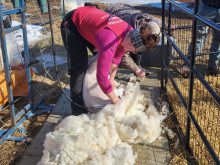A burden has been eased for cattle and bison producers living near a national park in Manitoba.
The Riding Mountain Tuberculosis Eradication Area was recently granted TB-free status by the Canadian Food Inspection Agency, giving it the same status as all other areas of Canada.
Producers of cattle and farmed bison no longer need movement permits from the agency to take their livestock out of the eradication area. Surveillance of their herds for the disease will also be eased, although not ended.
“It means a lot to them,” said Mary Paziuk, chair of the Manitoba Cattle Producer Association’s animal health committee.
Read Also

Charges laid after cattle theft
Saskatchewan RCMP lay two charges against a man after six cattle went missing.
“Financially it makes a difference because they just have a few less things that they have to worry about. And emotionally, definitely, it makes a significant difference.”
The special eradication area, which covers provincial game hunting areas 23 and 23A, was established around the national park in January 2003. It was in response to several findings of bovine TB in cattle and wild elk in or around Riding Mountain National Park.
That same year, bovine TB was confirmed in four beef cattle herds in the eradication area. The following year, the disease was confirmed in a dairy cattle herd in southeastern Manitoba, but it is believed the infection resulted from the movement of untested cattle from the Riding Mountain Eradication Area in 2002, before movement restrictions were imposed.
No new cases of bovine TB have been found in the area’s livestock since that time, making it possible to rank the area as TB-free under Canada’s Health of Animals regulations.
Although surveillance for the disease in livestock will not be eliminated, efforts will be made to ease the intrusion on producers as much as possible, said CFIA senior staff veterinarian Maria Koller-Jones.
A concern remains about the transmission of the disease between wildlife, particularly elk and deer, and farmed animals. Since 1998, 38 wild cervids in the area tested positive for bovine TB, including 31 elk and seven white-tailed deer.
Based on the findings to date, the CFIA regards the prevalence of bovine TB as low among wildlife in and around Riding Mountain. The area of most concern has been the western half of the park and privately owned land within six kilometres of the park boundary.
“We’ve got some reason to be optimistic that this is not a widespread or highly prevalent disease in wildlife, but we’ve also got to keep reminding ourselves that the risk is there,” Koller-Jones said.
For producers, having to assemble their herds for TB testing was one of the headaches during the more than three years of ongoing surveillance for the disease. However, the need for some measure of continued surveillance is not lost on cattle producers, said Paziuk.
Management practices that lessen the risk of disease transmission between wild animals and livestock will also continue to be encouraged, she said.
“We can’t totally let up our guard because we know that the possibility is still there in the future.”
The improved status of the Riding Mountain Eradication Area does not affect the requirements for exporting cattle to the United States, according to Koller-Jones.
Animals younger than 30 months of age for immediate slaughter or for feeding to be followed by slaughter can be exported to the U.S. from a TB-free or TB-accredited-advanced area without a test for bovine TB.
The U.S. Department of Agriculture continues to view all of Manitoba as TB-accredited-advanced, which is one level below TB-free. The department might publish a proposed new rule as early as next year concerning how it wants to screen against bovine TB in livestock imports.
“Until we see that rule, we won’t really know how they view what’s happened in Manitoba,” Koller-Jones said.
















